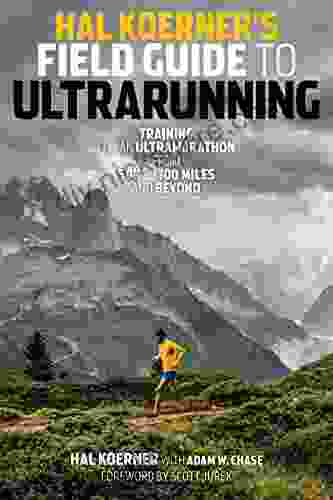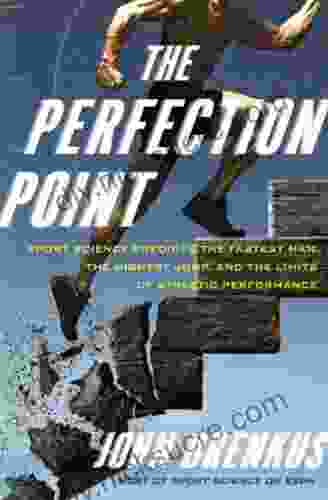Sport Science Predicts The Fastest Man, The Highest Jump, And The Limits Of Human Potential

Sport science is a rapidly growing field that is helping us to better understand the limits of human performance. By studying the biomechanics of movement, physiologists and engineers are able to predict how fast a person can run, how high they can jump, and how much force they can generate. This information is not only important for athletes and coaches, but it can also help us to understand the limits of human potential and to develop new ways to improve our health and fitness.
4.4 out of 5
| Language | : | English |
| Text-to-Speech | : | Enabled |
| Enhanced typesetting | : | Enabled |
| Word Wise | : | Enabled |
| File size | : | 4288 KB |
| Screen Reader | : | Supported |
| Print length | : | 260 pages |
The Fastest Man
The current world record for the 100-meter dash is 9.58 seconds, set by Usain Bolt in 2009. However, scientists believe that it is possible for a human to run even faster. A study by researchers at the University of Calgary found that a theoretical "perfect" runner could reach speeds of up to 12.42 seconds for the 100-meter dash.
This study used a computer model to simulate the biomechanics of running. The model took into account factors such as muscle strength, stride length, and ground contact time. The researchers found that the perfect runner would have a stride length of 2.7 meters and a ground contact time of 0.12 seconds. They would also generate a peak force of 2,500 Newtons.
While it is unlikely that any human will ever reach the speeds of the perfect runner, this study shows that there is still room for improvement in the world of sprinting.
The Highest Jump
The current world record for the high jump is 2.45 meters, set by Javier Sotomayor in 1993. However, scientists believe that it is possible for a human to jump even higher. A study by researchers at the University of Massachusetts found that a theoretical "perfect" jumper could reach heights of up to 2.75 meters.
This study used a computer model to simulate the biomechanics of jumping. The model took into account factors such as muscle strength, leg length, and takeoff angle. The researchers found that the perfect jumper would have a takeoff angle of 35 degrees and a leg length of 1.1 meters. They would also generate a peak force of 2,000 Newtons.
While it is unlikely that any human will ever reach the heights of the perfect jumper, this study shows that there is still room for improvement in the world of jumping.
The Limits Of Human Potential
The studies discussed above show that there is still room for improvement in the world of human performance. However, there are also limits to what humans can achieve. These limits are determined by our genetics, our physiology, and the laws of physics.
One of the most important factors that limits human performance is our body size. Larger athletes have an advantage in many sports, such as basketball and football. This is because they have more muscle mass and can generate more force. However, larger athletes also have a disadvantage in some sports, such as running and swimming. This is because they have more drag and less buoyancy.
Another factor that limits human performance is our physiology. Our bodies are not designed to withstand the extreme forces that are required for some sports. For example, the forces generated by a high jump can damage the knees and ankles. The forces generated by a sprint can damage the muscles and tendons.
The laws of physics also limit human performance. For example, the law of gravity prevents us from flying. The law of conservation of energy prevents us from creating energy out of nothing.
Despite these limitations, humans have made incredible progress in the world of sports. We have broken records and pushed the boundaries of human potential. And as sport science continues to grow, we will continue to learn more about what is possible.
Sport science is a fascinating field that is helping us to understand the limits of human performance. By studying the biomechanics of movement, physiologists and engineers are able to predict how fast a person can run, how high they can jump, and how much force they can generate. This information is not only important for athletes and coaches, but it can also help us to understand the limits of human potential and to develop new ways to improve our health and fitness.
4.4 out of 5
| Language | : | English |
| Text-to-Speech | : | Enabled |
| Enhanced typesetting | : | Enabled |
| Word Wise | : | Enabled |
| File size | : | 4288 KB |
| Screen Reader | : | Supported |
| Print length | : | 260 pages |
Do you want to contribute by writing guest posts on this blog?
Please contact us and send us a resume of previous articles that you have written.
 Fiction
Fiction Non Fiction
Non Fiction Romance
Romance Mystery
Mystery Thriller
Thriller SciFi
SciFi Fantasy
Fantasy Horror
Horror Biography
Biography Selfhelp
Selfhelp Business
Business History
History Classics
Classics Poetry
Poetry Childrens
Childrens Young Adult
Young Adult Educational
Educational Cooking
Cooking Travel
Travel Lifestyle
Lifestyle Spirituality
Spirituality Health
Health Fitness
Fitness Technology
Technology Science
Science Arts
Arts Crafts
Crafts DIY
DIY Gardening
Gardening Petcare
Petcare Lindsey Lapointe
Lindsey Lapointe Steven Raichlen
Steven Raichlen Roy Richard Grinker
Roy Richard Grinker Christine Wheeler
Christine Wheeler David J Vanbergen Jr
David J Vanbergen Jr Larit Levy
Larit Levy Byron Pitts
Byron Pitts Dale Dougherty
Dale Dougherty Sherrilyn Kenyon
Sherrilyn Kenyon Patrick Meechan
Patrick Meechan Jm Mason
Jm Mason Susan Striker
Susan Striker John Almberg
John Almberg Kerri Hummingbird Sami
Kerri Hummingbird Sami Tammara Webber
Tammara Webber Dale P Clemens
Dale P Clemens Scott A Ostrow
Scott A Ostrow Jose M Forero Bautista
Jose M Forero Bautista John Williams
John Williams Sadie Robertson Huff
Sadie Robertson Huff Joel David Hamkins
Joel David Hamkins Ryan Gray
Ryan Gray Amos Yong
Amos Yong A G Cairns Smith
A G Cairns Smith Don Fink
Don Fink Alexander Greenmaj
Alexander Greenmaj Kenay Keira
Kenay Keira Cassandra Clare
Cassandra Clare Tiara R Brown
Tiara R Brown Jan Morris
Jan Morris Bree Moore
Bree Moore Nicole Conway
Nicole Conway Tim Flanagan
Tim Flanagan John D Currid
John D Currid Din Daniels
Din Daniels Eric Sevareid
Eric Sevareid N J Enfield
N J Enfield Andrew Henderson
Andrew Henderson Mandy Rivers
Mandy Rivers Barbara J Bain
Barbara J Bain Catherine Rodgers
Catherine Rodgers Lauren Muhlheim
Lauren Muhlheim Tripp Bowden
Tripp Bowden Pintip Dunn
Pintip Dunn Heather Gudenkauf
Heather Gudenkauf Josh Skeen
Josh Skeen Zen Faulkes
Zen Faulkes David Magee
David Magee Bruce Lansky
Bruce Lansky Diane Burke Fessler
Diane Burke Fessler Dr Alan Whitcomb
Dr Alan Whitcomb Rosie Garthwaite
Rosie Garthwaite Bruce Collier
Bruce Collier Lauren Oliver
Lauren Oliver John Brenkus
John Brenkus Olivia Smith
Olivia Smith Jamal Moustafaev
Jamal Moustafaev Lucy Christopher
Lucy ChristopherA G
 Roxanne Martin
Roxanne Martin Scientia Media Group
Scientia Media Group Bear Heart
Bear Heart Lindsey Vonn
Lindsey Vonn Manoush Zomorodi
Manoush Zomorodi William Scott Wilson
William Scott Wilson Tom Jordan
Tom Jordan Hazel Holmes
Hazel Holmes Cyndi Kinney
Cyndi Kinney Helen Buckley
Helen Buckley Catherine Stonehouse
Catherine Stonehouse Caspar Craven
Caspar Craven Chris I Naylor
Chris I Naylor Barry Werth
Barry Werth Leandro Taub
Leandro Taub Rebecca Pelky
Rebecca Pelky Susanne Foitzik
Susanne Foitzik Kathlyn Gay
Kathlyn Gay Okina Baba
Okina Baba Lilith Mclelland
Lilith Mclelland Jennie Finch
Jennie Finch Todd Gitlin
Todd Gitlin Lisa Pease
Lisa Pease Adrian Dater
Adrian Dater Michelle Maccarthy
Michelle Maccarthy Diane Stresing
Diane Stresing Fernanda Pirie
Fernanda Pirie Anne Deans
Anne Deans Marc S Sabatine
Marc S Sabatine Katrina Abbott
Katrina Abbott Dr Howard Rankin
Dr Howard Rankin Lou Tabory
Lou Tabory Rekha Ramcharan
Rekha Ramcharan Lyla Lee
Lyla Lee Day Leitao
Day Leitao Saxton Pope
Saxton Pope Glenn Patron
Glenn Patron Mike Tidwell
Mike Tidwell Sarah Sutton
Sarah Sutton Jennifer Senior
Jennifer Senior Val Mcdermid
Val Mcdermid William Monk
William Monk A Roger Ekirch
A Roger Ekirch Steve Hindman
Steve Hindman Roger Zelazny
Roger Zelazny Len Fisher
Len Fisher Marcus Butler
Marcus Butler Katerina Griffith
Katerina Griffith Lillian Tibbles Phd
Lillian Tibbles Phd Carrie Harper
Carrie Harper A J Mackinnon
A J Mackinnon Rysa Walker
Rysa Walker Dirk F Moore
Dirk F Moore Peter Godfrey Smith
Peter Godfrey Smith Adam Savage
Adam Savage Susan Cooper
Susan Cooper Seth M Holmes
Seth M Holmes John L Messina
John L Messina Crystal Cestari
Crystal Cestari Eric Blehm
Eric Blehm A J Carlisle
A J Carlisle Max Tegmark
Max Tegmark Yasu
Yasu Jonathan S Rose
Jonathan S Rose Daniel S Pierce
Daniel S Pierce Peter Goldenthal
Peter Goldenthal A J Mackenzie
A J Mackenzie David Remnick
David Remnick Shanterra Mcbride
Shanterra Mcbride Peter Rees
Peter Rees David Spiegelhalter
David Spiegelhalter Francis Fukuyama
Francis Fukuyama Karla Helbert
Karla Helbert Corina Morariu
Corina Morariu Marlynn Jayme Schotland
Marlynn Jayme Schotland Paul Watzlawick
Paul Watzlawick Brian Clegg
Brian Clegg Filippo Coarelli
Filippo Coarelli Michael Shingleton
Michael Shingleton James Baldwin
James Baldwin Gabrielle Coleman
Gabrielle Coleman Bill Jones
Bill Jones Monte Burke
Monte Burke Raymonde Carroll
Raymonde Carroll Cath Smith
Cath Smith Shauna Lynn Panczyszyn
Shauna Lynn Panczyszyn Matilda Ramsay
Matilda Ramsay Homeira Qaderi
Homeira Qaderi Cynthia Ulrich Tobias
Cynthia Ulrich Tobias Marks Prep
Marks Prep Kevin Adams
Kevin Adams Megan Vickers
Megan Vickers Dawn Huebner
Dawn Huebner Winston Starr
Winston Starr Matthieu Ricard
Matthieu Ricard A J Stewart
A J Stewart Sonya Chappell
Sonya Chappell Chris Diamond
Chris Diamond Remy Agee
Remy Agee Blair Holden
Blair Holden Sky Marsen
Sky Marsen Dame Darcy
Dame Darcy Dan Romanchik Kb6nu
Dan Romanchik Kb6nu Susan Aud Sonders
Susan Aud Sonders Michael D Coogan
Michael D Coogan Hicham And Mohamed Ibnalkadi
Hicham And Mohamed Ibnalkadi Randy Friedman
Randy Friedman Robert P Harris
Robert P Harris Ray Ordorica
Ray Ordorica Jonalu Johnstone
Jonalu Johnstone Kelly Starrett
Kelly Starrett Helen E Johnson
Helen E Johnson Jack Grimshaw
Jack Grimshaw Andrea Falk
Andrea Falk Ken Castor
Ken Castor Michael Labossiere
Michael Labossiere Micha Gorelick
Micha Gorelick Georgia Varozza
Georgia Varozza Peter Nichols
Peter Nichols William C Oakes
William C Oakes Charles Edward Chapel
Charles Edward Chapel Michael Dell
Michael Dell A L Graziadei
A L Graziadei Freya Hoffmeister
Freya Hoffmeister Dmv Test Bank
Dmv Test Bank Mrjamvad
Mrjamvad A H Almaas
A H Almaas Frost Kay
Frost Kay Tanya Selvaratnam
Tanya Selvaratnam Vernon Trafford
Vernon Trafford Jennifer N Smith
Jennifer N Smith King Solomon
King Solomon Boston T Party
Boston T Party Christopher Small
Christopher Small Sam Warburton
Sam Warburton Mike Branon
Mike Branon Amanda Ostrander
Amanda Ostrander Iasha King
Iasha King Francis Pryor
Francis Pryor Joe Navarro
Joe Navarro Sarah Jo Brown
Sarah Jo Brown The R A
The R A W Timothy Gallwey
W Timothy Gallwey Russell Davis
Russell Davis Rebecca Black
Rebecca Black Chuck Whelon
Chuck Whelon A M Strickland
A M Strickland Michael Lanza
Michael Lanza Polly Moore
Polly Moore K A Riley
K A Riley Dave Lowry
Dave Lowry Jeff Kane
Jeff Kane Rens Bod
Rens Bod Alyssa Padgett
Alyssa Padgett Sandra Swenson
Sandra Swenson Eva Mauer
Eva Mauer Dr Kevin Leman
Dr Kevin Leman Tsao Lin E Moy L Ac Msom
Tsao Lin E Moy L Ac Msom Peter Maas
Peter Maas Sean Skahan
Sean Skahan Brad K Chambers
Brad K Chambers Peter Shelton
Peter Shelton Emily Evans
Emily Evans Ed Webster
Ed Webster Peter Zheutlin
Peter Zheutlin Dan Limbaugh
Dan Limbaugh Virginia Willis
Virginia Willis Mark Obmascik
Mark Obmascik Tony Wright
Tony Wright Jonathan Mckee
Jonathan Mckee Cristian Salcescu
Cristian Salcescu Valerio Varesi
Valerio Varesi Jec Aristotle Ballou
Jec Aristotle Ballou Gemma Milne
Gemma Milne Joe Pepitone
Joe Pepitone Heather Anderson
Heather Anderson A J Messenger
A J Messenger Jim Allen
Jim Allen Lou Zambello
Lou Zambello Lisa Murphy
Lisa Murphy Alf Wilkinson
Alf Wilkinson Jamie Vardy
Jamie Vardy Lilin Yang
Lilin Yang Eileen Tracy
Eileen Tracy Bob Plager
Bob Plager Sergey Kosarevsky
Sergey Kosarevsky Charles Szypszak
Charles Szypszak Rebecca A Moyes
Rebecca A Moyes William Minto
William Minto Zen Lylah
Zen Lylah A R Vasishtha
A R Vasishtha A F Stewart
A F Stewart John L Parker Jr
John L Parker Jr Dane Huckelbridge
Dane Huckelbridge Harrison Fluss
Harrison Fluss Grady Hendrix
Grady Hendrix Abigail Burd Lcsw Pmh C
Abigail Burd Lcsw Pmh C John Halligan
John Halligan Nancy Mckenzie
Nancy Mckenzie Rick Telander
Rick Telander Dr Stephanie Bloodworth Psyd
Dr Stephanie Bloodworth Psyd A J Hamler
A J Hamler R A Mejia
R A Mejia Erin Watt
Erin Watt Ari Tuckman
Ari Tuckman Loretta Sponsler
Loretta Sponsler Stephen R Lawhead
Stephen R Lawhead Jon Gillespie Brown
Jon Gillespie Brown Christiane Kutik
Christiane Kutik Thomas Mcguane
Thomas Mcguane Thomas R Martin
Thomas R Martin John Long
John Long Shelly Mazzanoble
Shelly Mazzanoble Anna Goldsworthy
Anna Goldsworthy Giordano Scalzo
Giordano Scalzo Pete Ripmaster
Pete Ripmaster Eric Armstrong
Eric Armstrong Andreas Quast
Andreas Quast David H Barlow
David H Barlow Pardha S Pyla
Pardha S Pyla Bryan Berg
Bryan Berg Mj Porter
Mj Porter Kenn Bivins
Kenn Bivins Noah Gift
Noah Gift Bob Trueman
Bob Trueman Certsquad Professional Trainers
Certsquad Professional Trainers Timothy J Gawne
Timothy J Gawne Timothy C Urdan
Timothy C Urdan Ridge Magee
Ridge Magee Stan Skinner
Stan Skinner Jim Vernes
Jim Vernes Raymond M Smullyan
Raymond M Smullyan Kathy Koch
Kathy Koch A G Howard
A G Howard Mark Ryan
Mark Ryan Matthew J Friedman
Matthew J Friedman Kenneth Cline
Kenneth Cline Watt Key
Watt Key Anne Sigismund Huff
Anne Sigismund Huff Jean Philippe Dionne
Jean Philippe Dionne Rafe Esquith
Rafe Esquith Sharie King
Sharie King Ken Alder
Ken Alder Chelsea Crockett
Chelsea Crockett Jennifer Longmore
Jennifer Longmore Vitaly Pedchenko
Vitaly Pedchenko William Ramsey
William Ramsey David G Taylor
David G Taylor David Deutsch
David Deutsch Flo Perry
Flo Perry Walter Dean Myers
Walter Dean Myers David A Wells
David A Wells Armin A Brott
Armin A Brott Arlin Smith
Arlin Smith Anji Andrews
Anji Andrews Karl Knopf
Karl Knopf Cathy A Malchiodi
Cathy A Malchiodi Niall Ferguson
Niall Ferguson Philip Yarrow
Philip Yarrow Ken Dryden
Ken Dryden Aaron Kleinmeyer
Aaron Kleinmeyer Joshua Akin
Joshua Akin Gary Gruber
Gary Gruber Rachael Allen
Rachael Allen John Mordechai Gottman
John Mordechai Gottman Raymond J Carroll
Raymond J Carroll Michael Lardon
Michael Lardon Alison Cotter
Alison Cotter Oba Ilari Aladokun
Oba Ilari Aladokun Shenyang Guo
Shenyang Guo George Francis Dow
George Francis Dow Linda Tuhiwai Smith
Linda Tuhiwai Smith Todd Downs
Todd Downs Elisabeth Fassas
Elisabeth Fassas Nick Jackson
Nick Jackson Sandra Niche
Sandra Niche Dean R Johnson
Dean R Johnson A L Knorr
A L Knorr Alex Karp
Alex Karp Todd Wanerman
Todd Wanerman Thomas C Tabor
Thomas C Tabor Jordan B Peterson
Jordan B Peterson Natalie Pompilio
Natalie Pompilio Paul Mccarthy
Paul Mccarthy Dr Tricia Groff
Dr Tricia Groff Sherine Hamdy
Sherine Hamdy Angela Himsel
Angela Himsel Upton Sinclair
Upton Sinclair Eugene Don
Eugene Don Lyndall Clipstone
Lyndall Clipstone Jonathan Eig
Jonathan Eig Laura Pohl
Laura Pohl Russell Sher
Russell Sher Richard Heath
Richard Heath Louis Jacques Dorais
Louis Jacques Dorais Helen Marot
Helen Marot Calvin L Chou
Calvin L Chou Joseph Mctaggart
Joseph Mctaggart Akash Kapur
Akash Kapur Bob Frye
Bob Frye Meghan Leahy
Meghan Leahy Jennifer Trainer Thompson
Jennifer Trainer Thompson Stan Tenen
Stan Tenen Linh Phung
Linh Phung Cailin O Connor
Cailin O Connor William Bauer
William Bauer Harry Yoon
Harry Yoon Val Emmich
Val Emmich Toni Natalie
Toni Natalie Anghel Leonard
Anghel Leonard A J Angulo
A J Angulo Charles Butler
Charles Butler Kenneth Cloke
Kenneth Cloke Garret Romaine
Garret Romaine A M Wilson
A M Wilson Jennifer L Armentrout
Jennifer L Armentrout E S Wynn
E S Wynn Judi Garman
Judi Garman Businessnews Publishing
Businessnews Publishing Anthony J Onwuegbuzie
Anthony J Onwuegbuzie Steve Angers
Steve Angers Jane Austen
Jane Austen Gordon Macquarrie
Gordon Macquarrie Helen Fitzgerald
Helen Fitzgerald Thomas Hager
Thomas Hager Taha Sochi
Taha Sochi Ray Bradbury
Ray Bradbury Leslie Stager
Leslie Stager Rina Kent
Rina Kent Mia Kankimaki
Mia Kankimaki William F Mann
William F Mann Ilya Ru
Ilya Ru Bruce Tremper
Bruce Tremper Philip Golding
Philip Golding Mitch Landrieu
Mitch Landrieu A K Davidson
A K Davidson Todd Rose
Todd Rose Zander Brumbaugh
Zander Brumbaugh Leigh Newman
Leigh Newman Soap2day Publication
Soap2day Publication Matt Brown
Matt Brown
Light bulbAdvertise smarter! Our strategic ad space ensures maximum exposure. Reserve your spot today!

 Yukio MishimaHal Koerner's Field Guide to Ultrarunning: A Comprehensive Guide to the Sport...
Yukio MishimaHal Koerner's Field Guide to Ultrarunning: A Comprehensive Guide to the Sport... E.M. ForsterFollow ·16.3k
E.M. ForsterFollow ·16.3k Dakota PowellFollow ·6.3k
Dakota PowellFollow ·6.3k Charles ReedFollow ·7.4k
Charles ReedFollow ·7.4k Jules VerneFollow ·17.9k
Jules VerneFollow ·17.9k Ethan GrayFollow ·4.2k
Ethan GrayFollow ·4.2k Haruki MurakamiFollow ·12k
Haruki MurakamiFollow ·12k Anthony BurgessFollow ·15.9k
Anthony BurgessFollow ·15.9k Dawson ReedFollow ·4.9k
Dawson ReedFollow ·4.9k

 Franklin Bell
Franklin BellHow Genesis Preserves Science Of Consciousness In...
The book of Genesis is...

 Ted Simmons
Ted SimmonsAt Day's Close, Night in Times Past
As the sun dips...

 Kenneth Parker
Kenneth ParkerRose Under Fire: Code Name Verity - A Heartbreaking and...
In the annals of...

 Jerry Hayes
Jerry HayesNurturing Massage for Pregnancy: A Comprehensive Guide to...
Pregnancy is...

 Blake Bell
Blake BellFill in the Blank: Word Kind of Animal Farm for Kids and...
This interactive fill-in-the-blank...
4.4 out of 5
| Language | : | English |
| Text-to-Speech | : | Enabled |
| Enhanced typesetting | : | Enabled |
| Word Wise | : | Enabled |
| File size | : | 4288 KB |
| Screen Reader | : | Supported |
| Print length | : | 260 pages |












